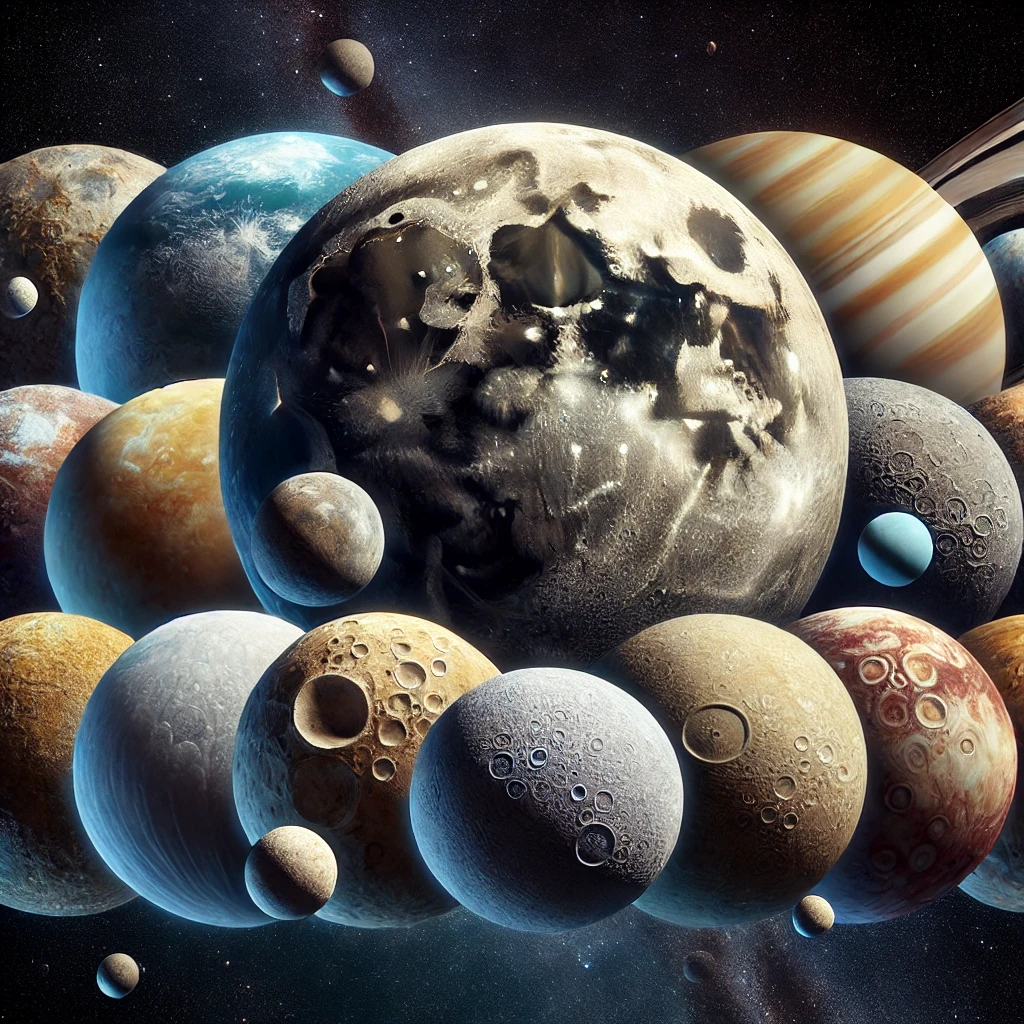Greetings, fellow cosmic explorers! Captain Nova here, broadcasting once again from the Odyssey Explorer. Today, on Day 18 of our “100 Days of Space Exploration” journey, we’re turning our attention to some of the most fascinating and enigmatic companions in our Solar System: planetary moons. These celestial satellites come in all shapes, sizes, and compositions, each with its own story to tell. Let’s dive into their mysteries and unravel the secrets they hold.

What Are Planetary Moons?
In simple terms, a moon is a natural satellite that orbits a planet or a dwarf planet. Our Solar System is teeming with them—over 200 known moons circling planets like Jupiter, Saturn, and even tiny Pluto. These moons range from barren rocky outposts to icy worlds that might harbor oceans beneath their frozen surfaces.
The sheer diversity among moons is astonishing. Some, like our very own Moon, play a vital role in their planet’s stability, while others, like Saturn’s Enceladus, could hold the key to finding extraterrestrial life.
Earth’s Moon: A Familiar Face with Hidden Depths
Let’s start close to home. Earth’s Moon has been a companion to humanity for millennia, inspiring myths, art, and scientific discovery. Its gravitational pull influences our tides and even stabilizes Earth’s axial tilt, which helps regulate our climate.
But despite its familiarity, the Moon still holds mysteries. For instance, scientists continue to investigate its origin. The leading theory, the Giant Impact Hypothesis, suggests that a Mars-sized body collided with Earth billions of years ago, ejecting material that eventually formed the Moon. Yet, questions about its internal structure and the presence of water in its shadowed craters remain open.
Mars’ Moons: Phobos and Deimos
Moving outward, Mars has two small moons, Phobos and Deimos. These irregularly shaped rocks are likely captured asteroids, remnants of the early Solar System. Phobos, the larger of the two, is gradually spiraling inward and may one day break apart, forming a ring around Mars. Scientists are eager to explore these moons further, as they may offer clues about the planet’s past and its potential for hosting life.
The Giant Moons of Jupiter
Jupiter, the king of planets, boasts 95 confirmed moons, but the four largest—the Galilean moons—are the true showstoppers:
- Io: The most volcanically active body in the Solar System, Io’s surface is constantly reshaped by lava flows and sulfur geysers.
- Europa: Beneath its icy crust lies a vast subsurface ocean, making Europa one of the most promising candidates in the search for extraterrestrial life.
- Ganymede: The largest moon in the Solar System, Ganymede even has its own magnetic field—a feature unique among moons.
- Callisto: A heavily cratered and ancient world, Callisto’s surface may hold clues to the early days of our Solar System.
Saturn’s Icy Wonders
Saturn, famous for its dazzling rings, is also home to 146 moons and counting. Among them, Titan and Enceladus stand out:
- Titan: The second-largest moon in the Solar System, Titan has a dense atmosphere and surface lakes of liquid methane and ethane. Its thick haze hides a world that might resemble early Earth.
- Enceladus: This tiny moon astonished scientists when geysers of water ice were observed erupting from its south pole. These plumes likely originate from a global subsurface ocean, making Enceladus another prime candidate in the search for life.
Uranus and Its Tilted Companions
Uranus, the ice giant with a dramatic axial tilt, has 27 known moons. The largest, Titania and Oberon, show signs of ancient geological activity. Scientists speculate that some of Uranus’ moons might have subsurface oceans, though much remains unknown due to the planet’s vast distance from Earth. Future missions could unveil more secrets about these mysterious worlds.
Neptune’s Captive Moon: Triton
Neptune’s moon Triton is a peculiar case. Unlike most moons, Triton orbits its planet in the opposite direction of Neptune’s rotation, suggesting it was likely a captured object from the Kuiper Belt. Triton’s surface features geysers that spew nitrogen gas, and like Europa and Enceladus, it may harbor a subsurface ocean. Its retrograde orbit and icy surface make it a unique and compelling target for future exploration.
Pluto’s Moons: Beyond the Planetary Realm
Though Pluto is now classified as a dwarf planet, it boasts five known moons, with Charon being the most significant. Charon is so large relative to Pluto that the two are considered a binary system, orbiting a common center of gravity. The dynamic between these two bodies offers a glimpse into the complexities of the outer Solar System.
The Mysteries Await
From volcanic moons to icy worlds that may conceal oceans, the moons of our Solar System are as diverse as they are intriguing. Each one has its own story, and studying them helps us piece together the grand narrative of planetary formation and evolution.
As I gaze at these celestial companions from the Odyssey Explorer, I’m struck by how much we’ve learned—and how much we still have to discover. Tomorrow, we’ll delve into the fascinating history of how planets get their names. Until then, keep your curiosity alive and your sights set on the stars.
Captain Nova
Odyssey Explorer
Leave a Reply